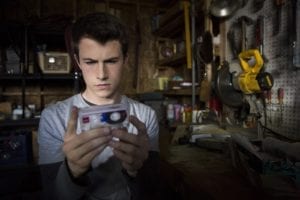 I had been waiting for that letter. It had been weeks that I had been hearing about the show “Thirteen Reasons Why” that had become a global phenomenon. But this was no ordinary show. This was a show about teen suicide, one that graphically depicted it, and that kids had easy access too. One that could potentially hurt a kid that was already hurting.
I had been waiting for that letter. It had been weeks that I had been hearing about the show “Thirteen Reasons Why” that had become a global phenomenon. But this was no ordinary show. This was a show about teen suicide, one that graphically depicted it, and that kids had easy access too. One that could potentially hurt a kid that was already hurting.
Many school districts across the nation had already begun sending home letters, warning parents about the show. And although my kids are much younger than teenagers, I was very aware that even these sorts of things seem to somehow make their way into school hallways. So after hemming and hawing about watching the series, I told myself that if the Superintendent of Broward County Schools sent home a letter, I would watch it. I prayed I wouldn’t have to. But then I opened my phone and saw the letter from the Superintendent, and I knew I’d have to watch it.
I signed up for a thirty day trial on Netflix to watch all thirteen episodes. The series, based on the book by Jay Asher, highlights the thirteen reasons why a beautiful and vibrant teenager decided to take her own life. The series itself is a slow and painful death, and follows the story of a teenage girl named Hannah who moves to a new school. The episodes are told from a haunting past, as Hannah recounts the awful and mean things that kids did to her and said about her. This may sound harmless enough, but it gets much worse.
 Suicide is final
Suicide is final
You see, Hannah is telling the story from beyond the grave. When the series opens, she is already dead. And ultimately she has gained the advantage in death by telling everyone what they did to her and recording it on cassette tapes that ultimately end up in the hands of the kids who she says is responsible for her death. The story is gruesome as Hannah recounts acts of bullying, embarrassment and even rape. It would have been disturbing enough to have heard her recount it from the dead, but became more disturbing when the producers of the show decided that we had to see it. Yes, everything. The disturbing pictures, the drinking, the drugs, the rape and yes the suicide — a slow, painful and very graphic suicide.
As an attorney who has represented hundreds of children, many of whom suffered from mental illness, were victims of sexual abuse or tried to take their own lives, I sat after binge watching these thirteen episodes and cried. I couldn’t imagine how a child, any child, could sit and be exposed to this violent and unapologetic series without first talking to an adult or making an adult aware that they were watching it. There are so many children who would not and could not be ready to watch something like this. As teenagers, there would be no way for children to process this alone, if at all.
The producers and stars of this series have collectively said that they wanted to make it as real as possible and show suicide for the ugliness that it is. But it is maddening and irresponsible to believe that any child may not have the idea from this series that death is not final. With a dead girl talking and getting her vengeance, it was even hard for me to process that she was really dead.
Start the conversation
It is inevitable that many children, your children, will watch this series without even telling you. And that is why it is so important that we as parents start the conversation first. Should we choose to watch the series with our teenage children, we can be their guides, helping them to process what they are seeing. But I have to warn you, the content is extremely graphic.
Whatever your decision, I think the series is a great reminder that we must be involved in every aspect of our children’s lives. Many times, they may not be able to process emotions and embarrassing encounters. Incidents of bullying may go undetected. We cannot and must not think that our children are not hurting because they haven’t said anything; most kids don’t. But if we keep that open line of communication and start the conversation first, our homes will become safe spaces.
Don’t miss the opportunity to start the conversation. You may not have heard of the series before you read this article, but be certain your kids have. Talk to them about it, but most importantly let them also talk to you. The teenage years can be traumatic and complicated. Make this your open door.
Melissa Zelniker Presser is an attorney and freelance writer living in South Florida. When she isn’t arguing, you can find her blogging at www.godisinyourtypewriter.com.

Comments